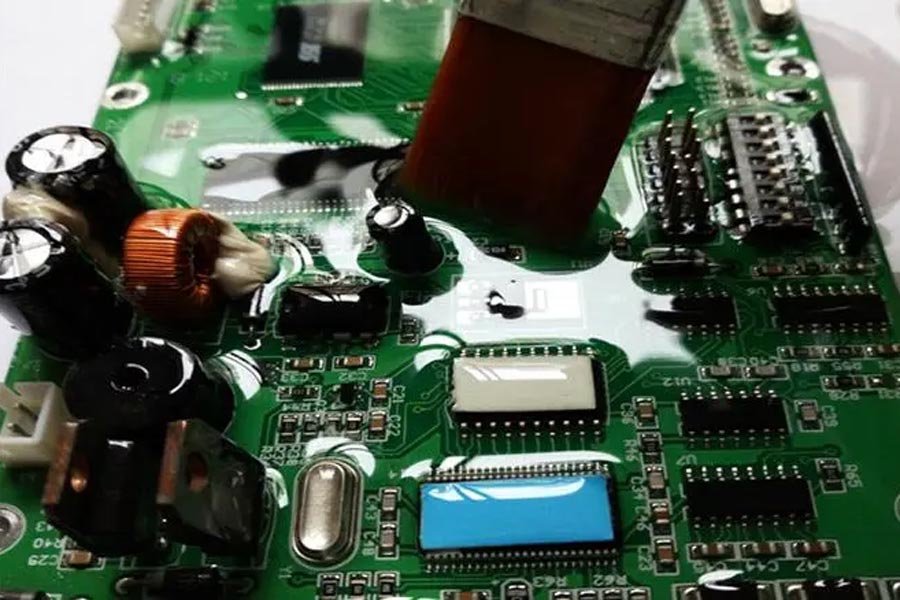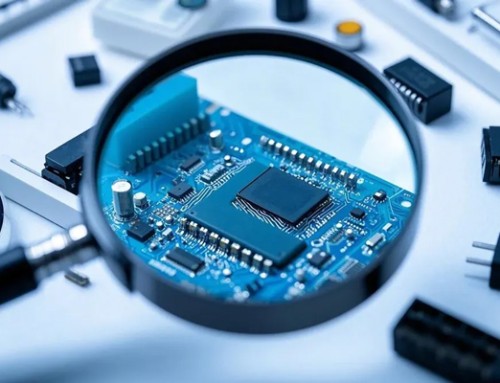-A conformal coating protects the components and exposed copper on a PCBA from damage
-The state of a component, particularly cleanliness, impacts how conformal coating works.
-Masking is a useful way to prepare a PCB or component for the conformal coating process.
Electronic components and exposed conductors are vulnerable to chemical or mechanical degradation during their lifetime. Consumers and commercial users expect electronics to be reliable and have a long lifetime, so manufacturers have developed ways to protect PCBAs from damage and ensure they remain functional. One of these protective measures is to apply a conformal coating. This process protects PCBAs from chemical damage, extending their lifespan and reliability in multiple ways.
Which conformal coating should be applied, and what are the advantages of different coating materials? There are several materials that are candidates for conformal coating, and these have a range of different electrical and chemical properties. In addition to the conformal coating process, we will briefly look at the different types of coatings and some application areas for their use.
What is a Conformal Coating?
A conformal coating is a polymer film that protects a PCBA from chemical damage. When we say “chemical damage”, we mean exposure to substances or environmental conditions that can put the reliability of a PCBA in jeopardy. The primary motivation for using conformal coatings is to prevent moisture uptake (exposure to humidity), prevent exposure to corrosive substances, or both. There are other benefits, such as a modified dielectric strength in the layer around the board, which could provide protection against electrostatic discharge. These coatings are essential to protecting aerospace components from extreme conditions and were originally developed for mission-critical applications. In the modern digital age, the conformal coating process has become commonplace in many applications, including some used by the general public, like mobile devices.
Standards for Conformal Coatings
Many conformal coatings are required to meet strict international standards, so creating a conformal coating process that adheres to those standards is essential. The main standard for conformal coatings is IPC-CC-830C, and it contains sections for every variant of conformal coating, along with specific concerns for a variety of environmental issues. These issues include water, fungus, and flammability. The standard also includes guidelines for using different materials and processes when making electronics. Other international standards exist for specialized use cases, including electronics assemblies and soldered electronics. In total, three different international electronics standards deal wholly or partly with the conformal coating process.
Material Systems for Conformal Coatings
Conformal coatings are usually a form of resin mixed with water or various solvents, which can be applied in a variety of ways. Conformal coatings that are purely resin-based are semi-permeable, but waterproof and impermeable. Typically, the conformal coatings used on electronic components are the semi-permeable variety.
Most resin-based conformal coatings are made from one of three different resin types: acrylic, silicone, or polyurethane. Each resin has specific strengths in harsh environments. For example, acrylic resins have a high dielectric strength, while silicone resins are resistant to salt spray. Polyurethane is resistant to abrasion, moisture, and chemicals. Depending on their strengths, each conformal coating type must go through specific processes if they are to be removed. Acrylic coatings can be removed comparatively easily with solvents, but silicone and polyurethane coatings require specialized solvents, agitation from an ultrasonic bath, and a long soak time.
Here is a summary of the standard conformal coating options used for PCBAs:
-Polyurethane: Best for devices that need abrasion resistance as well as high humidity and corrosion resistance.
-Parylene: Has high resistance to solvents and high dielectric strength, but will degrade during exposure to humidity.
-Silicone: Also provides humidity and corrosion resistance, but has to be peeled if being removed from a device.
-Acrylic: An alternative to polyurethane that does not provide corrosion resistance, but is easy to remove with solvents.
-Epoxy: This is applied as a 1-part or 2-part compound and provides competitive humidity and corrosion resistance; it is resistant to solvents.
There is also a type of coating called a non-conformal coating. These coatings are made similarly to conformal coating, but they don’t conform as closely to the surface features of an electronic component. They also tend to be thicker than conformal coatings, making rework or repairs much more difficult.
Preparing for the Conformal Coating Process
It is essential that a component’s surface is free of impurities and physical defects before the conformal coating process begins, as uneven coating due to debris can result in corrosion, short circuits, or physical damage. There are also a number of other adhesion problems that can result form a badly prepared board, including discoloration or an uneven finish. One adhesion problem with a memorable name is “fish eyes”, which happens when little craters form on the surface of the coating due to the coating material running unevenly across the board as it sets. Spray coatings applied from a can or automated equipment can experience this problem if the coating is applied too thick.
Targeted Conformal Coatings Through Masking
When placing conformal coatings on a component, there are certain areas that should be left uncoated. These areas can include exposed metal on connectors, solderable holes used to connect wires, mounting holes used for grounding, and some LEDs. Preventing these areas from being coated involves a process called masking. Aside from these areas, conformal coatings are generally applied to an entire PCBA in order to create a complete, uniform barrier against humidity and corrosion.
A few masking techniques include:
-Shields or stencils: These are generally used in high volume production, where coatings need to be quickly applied in a single spraying process.
-Tapes: These can be manually applied, but they are only useful in prototyping. Careful solvent choice is required to prevent the adhesive on tapes from dissolving and contaminating the PCBA.
There is no specific technique that is always best for a particular masking scenario, and designers must consider many factors before masking. The shape, geometry, and function of the masked area, along with the level of protection given by the masking. Designers must also take into account the expected lifespan of the masking and how difficult it would be to remove the masking if necessary.
Some masking techniques are permanent in preventing the adhesion of conformal coatings, while some are temporary. Permanent liquids and gels are common, but some new technologies have opened up more possibilities in temporary masking. Temporary masking
liquids that can be cured with ultraviolet light are a recent addition. They are easy to apply and remove without requiring physical media like shields or tape. In addition, they don’t have the same restrictions as solid masking materials on board geometry. Despite these advantages, these temporary liquids require skilled application and removal techniques-although some automation is possible, a skilled technician must direct the application tools, and the process to do that is not trivial.




